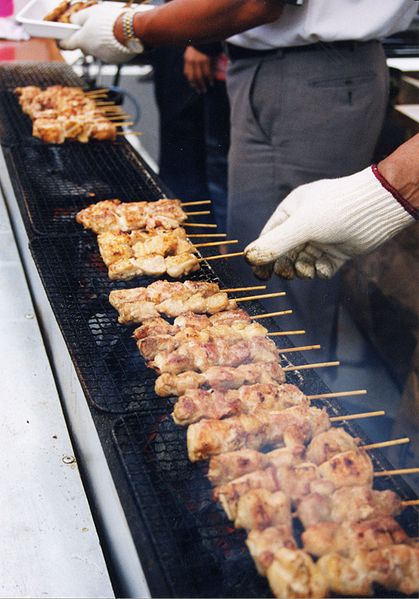 |
| Typical nabe pot with single burner stove |
Ingredients for nabe include the following: cabbage, thinly sliced meat (beef or pork), mushrooms (esp. SHIITAKE, but also ENOKI [thin, white stringy things]), green onions, KONYAKU (a vegetable-based gelatin substance, either in cube form or noodles), tofu, spinach, sliced leeks. Really, you can put anything in NABE as long as it tastes good with the other ingredients.
For the broth, you can be really simple and use just water, or add a little DASHI or some other stock flavoring.
JustHungry.com has a great post on a classic nabe, sukiyaki, including lyrics for the most popular karaoke song of all time: Sukiyaki. For a chicken nabe, check this JustHungry.com post.My point is that it's simple. Put liquid in earthen pot/basin thingy, put on heat, and add ingredients to your liking. Simple, healthy, yummy, and participatory.
After the ingredients have had some time to cook, pull out small amounts by tongs or chopsticks, place in little bowls that everyone should have, and go to town. We especially like to put a little PONZU (citrus-flavored soy sauce) in our bowls and zest up the broth. I also like adding a bit of TOHGARASHI (Japanese red pepper) to give it a kick.
 Note: for the meat, we like to get pre-sliced frozen pork from the ever-awesome Buford Highway Farmer's Market in Atlanta, but you can buy pork loin or a cut of sirloin and cut as thin as possible, similar to the kind of sliced meat you might want to add to SHABU SHABU.
Note: for the meat, we like to get pre-sliced frozen pork from the ever-awesome Buford Highway Farmer's Market in Atlanta, but you can buy pork loin or a cut of sirloin and cut as thin as possible, similar to the kind of sliced meat you might want to add to SHABU SHABU.Note: partially freeze your meat before slicing thin for easier cutting
And, finally, a great night of NABE ends with a healthy dose of (pre-boiled) RAMEN or UDON noodles in the broth. This both takes advantage of the absorbed flavors of the broth and provides a nice little carbo kick at the end of the meal to ensure proper nutrition and absorption of the beer that was drunk during the eating of the NABE.
 |
| Adding the ramen |
NABE: Japan's version of fondue that is as wonderful as it is flexible and delicious (OISHII!!!).
Enjoy.
After getting his M.A. in Japanese Art History, Trey Hoffman eschewed university life for Japanese business. He's worked for four Japanese companies in the U.S.; for a U.S. state office in Japan; and for a Japanese City Hall in the JET program. A father and husband, Trey enjoys teaching his kids about other cultures and introducing them to bizarre foods.











